Conestoga Cover” - “To Be
or Not To Be
Three years ago, when I first wrote on this subject, I was
‘bitching’ about it being, “ 30 Degrees; rain
& sleet; grey and overcast”. Well, now it’s
Saturday afternoon, the third {or fourth ?} snow fall of the
‘season’ just ended and another is on it’s
way for tomorrow night. It’s the only the end of January
. . . not even ‘Groundhog Day’!! AND, it’s
15 degrees, 12mph wind, and predicted to go down to ‘single
digits’ tonight.
“No great problem with my sailboat wrapped up in my back
driveway...” is what I said last time. This year Quahog
isn’t there. She is snuggled down, with a lot of ‘companions’,
in the dry storage area at the ‘Red Dragon’.
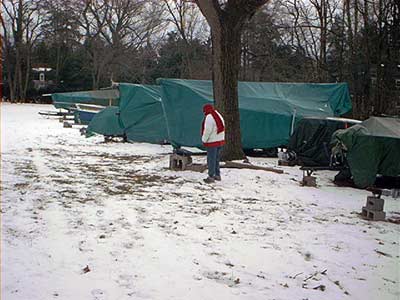
She now ‘wears’ a Green tarp {as does her smaller
‘sister’ - which IS in our yard . . . along with
another ‘friend’ so she won’t be lonely}.
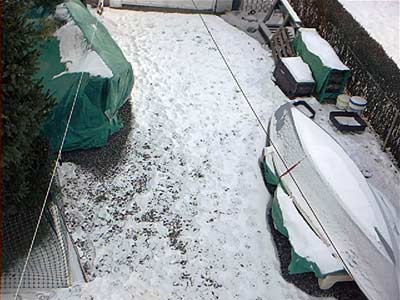
Because of the trip to Alaskan Malamute National Speciality
{so Zoe could go back to winning in the Veterans}
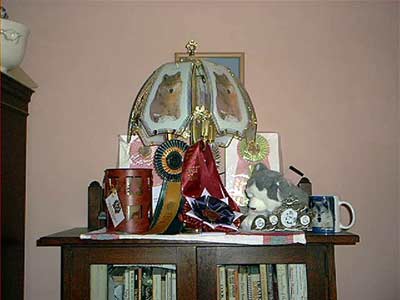
and my subsequent unexpected sojourn in the CCU, I wasn’t
able to set-up the usual support ‘hoops’. However,
much thanks to Don, Tom, and the others for wrapping her up
for me. In fact, they did such a ‘snug’ job that
when Joanne & I went over to retrieve a few items {and maybe
slip the hoops ‘under’}we couldn’t bring ourselves
to ‘unwrap’ her.
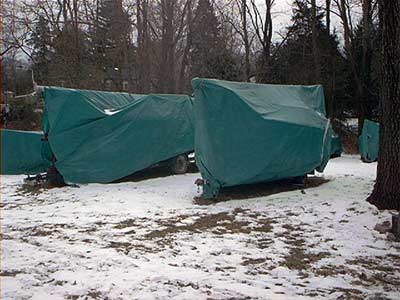
The 20 degree differential I spoke of, under the silver-grey
plastic tarp; is probably even greater under the Green one;
a darker color absorbing heat, etc. While the fore & aft
ends are closed, the open bottom should provide enough air flow
to ventilate {to prevent mildew} and the mast ‘ridge pole’
{ends WELL PADDED} with the snug tarp should give the ‘self
shedding’ action for snow.
For the ‘new guy’ {as the 5th of January our ‘probation
period’ was over . . . and Joanne was appointed, Fleet
Surgeon, with her own pennant . . . now I’ll have to salute
her! } I think we ‘performed’ pretty well. While
the actual ‘wrapping’ was done by others, Joanne
and I did the padding ‘prep work’, supplied a proper
sized & cared-for tarp, and a jack-stand for
the rear of the trailer. The reason for the emphasis
is the ADMONITION by the Commodore, at the last meeting , that
the Members should check their boats after storms . . . some
already had their ‘noses in the air’ due to cockpits
filled with water, covers ‘caved in’
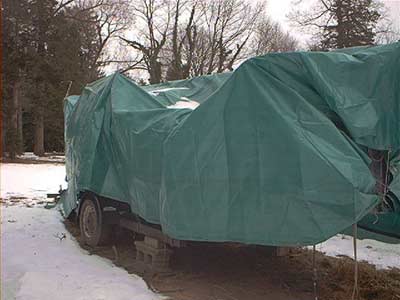
leaking, etc. Some of these people have owned boats for 50
years . . . gotten a little forgetful ? Or just figure a ‘plastic
tarp’ should last ‘like they used to’?
Either way, it prompted me that perhaps it would be a good
time to remind everybody . . . there are ALWAYS procrastinators.
At least to - MAKE SURE the boat is SECURED to the trailer
{or yard stands} and that the TRAILER IS SECURE on JACK STANDS
or HEAVY DUTY SUPPORTS.
Your typical micro- or mini-cruiser has a bow pulpit. {If not,
this is a wise investment to think about installing.}. The “trailerables”
have some sort of mast crutch that fits the rudder gudgeons.
If you don’t have one there are the handyman’s staples
of 2x4's or PVC pipe readily available. Pad the top of the bow
pulpit; I use a split section of HEAVY RUBBER GARDEN HOSE.
Suspend the mast across the protected pulpit forward and the
mast crutch aft; adjust the mast position so that only 2 or
3 feet projects behind the transom. Disconnect any shrouds if
necessary. If your trailer tongue sticks out beyond your bow
by 4 to 5 feet it can be protected by the cover and a is a securing
point as well. Make a support for the middle of the
mast; mine is a simple piece of 2 x 4 held in the tabernacle.
This will prevent “bowing”. I secure the mast ends
with inexpensive rubber straps. Cheaper than ‘Bungee Cord’
for winter use.
Everybody either has worked with “plastic pipe”
or has seen the stuff in the local ”hardware emporium”.
It’s usually indicated as “Schedule 40" or
60 or 80, etc. depending on it’s intended
use. This, because of CODE, is printed along the length of pipe
itself. “Plastic” pipe by it’s very nature
is a thermoplastic material. That
is, it softens with heat, and printed on the pipe is the key
... “ not for use above 140F”. A little applied
logic about safety margins, wall thickness, volumes, and curves,
and I had it.
At sea level water boils at 212F, PERIOD. No matter how long
it boils it won’t get above that temperature. There was
my constant. The pipe was HEAVY gauge PVC water pipe, NOT the
translucent plastic or grey drain pipe. I wanted; several “hoops”
from the bow pulpit to the aft mast gallows, looped over the
supported mast. With padded blocks
of wood for feet, resting against cleats or toerail, they would
act as “flying buttresses” and take the strain of
the cover, NOT the mast.
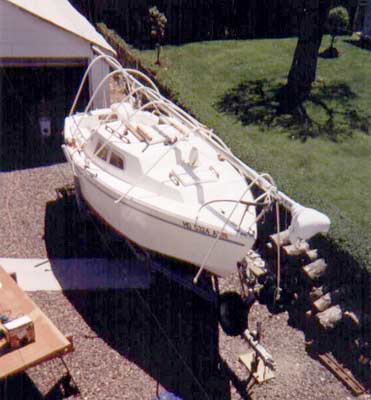
To get the proper “curve” I measured gunnel-to-gunnel
at the points of intended support. I then calculated the VOLUME
per INCH (inside diameter) of the pipe. I used ½ inch
for pulpit and gallows, 1 inch for the rest. A 2"x4"x
8 feet long ( my West Wight Potter, “QUAHOG” has
a 7ft max beam), a ladder and some shock cord was my “forming
jig”. Depending if you have help or not, you may need
to have some pegs and a drill.
Secure one end of the pipe to the 2x near one end. (Drill a
DEEP hole, use a THICK peg, secure the pipe AGAINST the peg
with shock cord) Wrap it well with the shock cord. This will
be the “base point” for all bends. Measuring from
there mark where the other end, (beam-to-beam), will be. Now
you’re going to need some muscle and CARE. BEND the free
end up to which ever mark is desired, and SECURE it with the
shock cord. THERE IS A LOT OF STRESS HERE, SO BE CAREFUL. Place
the 2x over the ladder, or some other place which will allow
access to the OPEN ENDS of the pipe and the curve to hang down.
Measure the CURVED AREA; tangent around to tangent, as if it
were half a circle. MULTIPLY that times the VOLUME per INCH
for how much BOILING water to use. DON’T
FILL the pipe, it will form a CIRCLE,
you may lose your attachment points and be scalded.
For a SMOOTH curve, use a funnel and pour HALF
the calculated quantity of water into EACH END
of the pipe. [If you do this when it’s cold the curve
develops almost magically; it’s fun to watch it equilibrate
itself ] After the curve has “settled” spray it
with cold water, then lay the whole thing down and flush it
with cold water.
It really takes longer to describe than to do. Really no waste;
10 ft sections of pipe are standard, can be joined for longer
lengths, and just about last forever. The “jig”
is any 2x4 and can then be used for whatever else you want,
and everybody has lengths of “bungee cord”.
Pad the top “side” of the mast. Old sheets, blankets,
towels, or sails . . . anything that will prevent chafe or puncture.
Pad the ends too . . . I padded and used plastic buckets.
{this year a 6 inch PVC , 90 degree ‘elbow’}
Now comes the reason for all the padding.
A 19ft x 25ft “Ultra Heavy Duty, PLASTIC COATED, guaranteed
for 3 years” silver-gray tarp only cost $45.00
[the Green one is actually LESS]- - - BUT you CAN PUNCTURE IT.
Get a hank of polyester tie-down line, use the grommet points
and GENTLY PULL the tarp over the “ridgepole” created
by the mast. Wrap the tarp around the boat {and trailer tongue,
if desired} and tie it down snugly but not “bowstring
tight”.
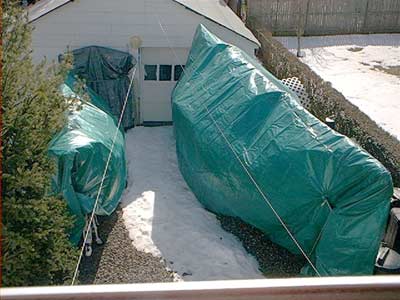
The fact that you are above the ground, and the ends of a
rectangle are wrapped around, allows air circulation. Now, even
if you don’t go aboard until spring, you won’t have
mildew growing over everything. With a transom mounted boarding
ladder, or a short step ladder and a little advance thinking
on your wrapping technique, it’s an easy matter to get
in and out of the cockpit.. The amount of headroom you have
depends on your mast crutch arrangements.
Please note, by comparing the photos, that while the hoops
are not necessarily essential, they do make a nice ‘recloseable
package’. If you want - or NEED - to do work over the
winter, it certainly is handier.
To paraphrase Jimmy . . . “Boat drinks, give me Boat Drinks
. . . I gotta go where it’s WARM !!”

